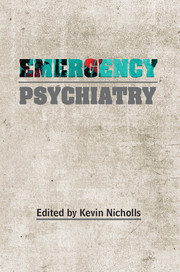Book contents
- Frontmatter
- Contents
- List of contributors
- Acknowledgements
- Preface
- 1 Assessment of suicide risk
- 2 Violence and aggression
- 3 Substance misuse emergencies
- 4 Alcohol and psychiatric emergencies
- 5 Acute psychosis
- 6 Acute side-effects of psychotropic medication
- 7 Emergencies in child and adolescent psychiatry
- 8 The psychiatric intensive care unit
- 9 Safeguarding
- 10 Emergency electroconvulsive therapy
- 11 Life-threatening medical emergencies in a mental health unit
- 12 Emergencies in intellectual disability psychiatry
- 13 Emergencies in older persons’ psychiatry
- 14 Perinatal psychiatric emergencies
- 15 Civilian and military psychological trauma
- 16 Emergencies in liaison psychiatry
- 17 Psychiatric emergencies in deaf people
- 18 Mental health law
- 19 Self-poisoning: aspects of assessment and initial care
- Index
16 - Emergencies in liaison psychiatry
Published online by Cambridge University Press: 01 January 2018
- Frontmatter
- Contents
- List of contributors
- Acknowledgements
- Preface
- 1 Assessment of suicide risk
- 2 Violence and aggression
- 3 Substance misuse emergencies
- 4 Alcohol and psychiatric emergencies
- 5 Acute psychosis
- 6 Acute side-effects of psychotropic medication
- 7 Emergencies in child and adolescent psychiatry
- 8 The psychiatric intensive care unit
- 9 Safeguarding
- 10 Emergency electroconvulsive therapy
- 11 Life-threatening medical emergencies in a mental health unit
- 12 Emergencies in intellectual disability psychiatry
- 13 Emergencies in older persons’ psychiatry
- 14 Perinatal psychiatric emergencies
- 15 Civilian and military psychological trauma
- 16 Emergencies in liaison psychiatry
- 17 Psychiatric emergencies in deaf people
- 18 Mental health law
- 19 Self-poisoning: aspects of assessment and initial care
- Index
Summary
Clinicians working in general hospitals can expect to see the full spectrum of psychiatric and psychological presentations, ranging from time-limited distress through to highly disturbed behaviour caused by serious mental or medical illness. The general hospital is a particularly challenging environment in which to diagnose and treat mental illness, both in terms of the types of disorders that present and the nature of the hospital environment itself.
In this chapter, I will focus on a number of disorders that commonly present in an acute manner to the general hospital, including medically unexplained emergencies and presentations for which the presence of physical disorder is a complicating factor in terms of aetiology or management.
Behavioural disturbance in the general hospital
A request for assessment of an acutely disturbed patient, such as the one shown in case study 1, is among the most common reasons for referral to a liaison psychiatry team (Bronheim et al, 1998). A recent survey of general hospital wards in Leeds found that the prevalence of disturbed behaviour, as identified by senior nursing staff, was 4% and that the management of this behaviour consumed a disproportionately high amount of nursing time (Kannabiran et al, 2008).
Case study 1
A 40-year-old woman who is undergoing potentially curative chemotherapy for leukaemia is admitted to the acute oncology ward, having developed problems swallowing. The cancer nurse specialist who has met her on several previous occasions notices that the patient has been more irritable and withdrawn than usual during the first 24 h of her admission. This irritability slowly increases over the ensuing days and culminates in the patient becoming hostile and aggressive to staff, attempting to pull out her central line and trying to leave the isolation area in which she is being treated. The patient is likely to die if the chemotherapy is not given.
Psychiatric staff are generally familiar with the challenges that patients with disturbed behaviour present in the psychiatric setting, but managing such challenges in the general hospital environment can be difficult. General hospital staff are far less likely to be familiar with disturbed behaviour and can find such presentations highly anxiety provoking.
- Type
- Chapter
- Information
- Emergency Psychiatry , pp. 265 - 285Publisher: Royal College of PsychiatristsPrint publication year: 2015



